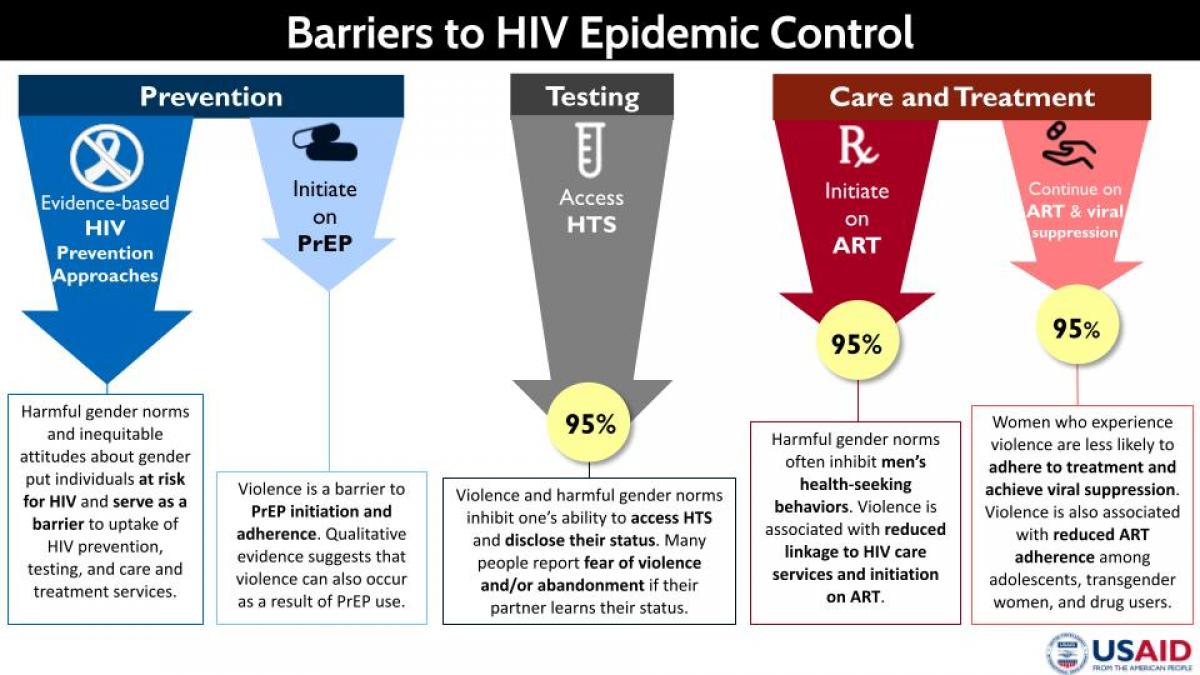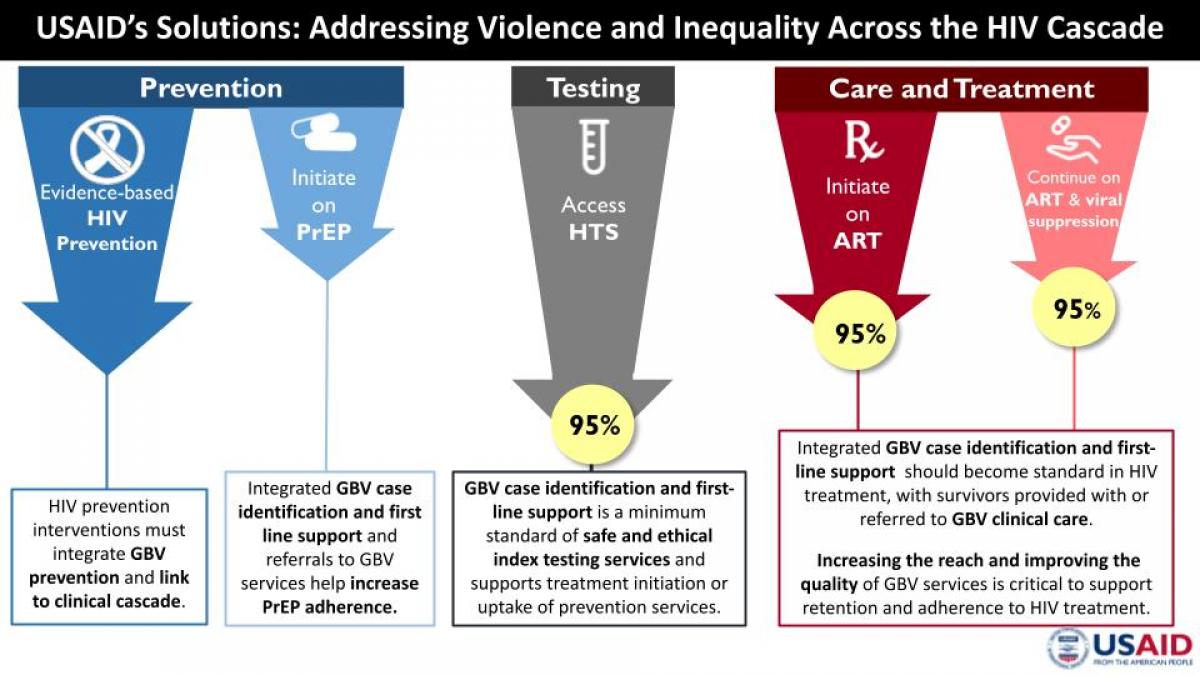About the authors: The authors work in the Office of HIV/AIDS -- Amelia Peltz is the Senior Gender Advisor/Team Lead and Emily Reitenauer is a Gender Advisor in the Priority Populations, Integration & Rights Division.
When women receive inadequate or unequal access to health care, or when they are the victims of gender-based violence, they do not have the opportunity to understand their health or even make decisions about their health. Gender inequality and gender-based violence (GBV) are some of the most critical barriers to ending the HIV epidemic, which includes ensuring 95 percent of people living with HIV (PLHIV) know their HIV status, 95 percent of PLHIV who know their status are on antiretroviral therapy (ART), and 95 percent of PLHIV on ART are virally suppressed and therefore can’t transmit the virus. Globally, 35 percent of women experience intimate partner violence or non-partner sexual violence in their lifetime, and women who experience intimate partner violence are 1.5 times more likely to acquire HIV. The experience of GBV is associated with negative outcomes across the HIV treatment cascade -- that is, the steps of care that people living with HIV go through from prevention, testing, care and treatment, and viral suppression.
Specifically, GBV is associated with:
- lower use of antiretroviral treatment,
- half the odds of self-reported ART adherence, and,
- significantly worsened viral suppression among women.
Intimate partner violence has also been found to lower adherence to pre-exposure prophylaxis (PrEP). In short, violence poses a substantial barrier to the effectiveness of HIV services and can undermine the uptake of and adherence to proven biomedical prevention and treatment options.
When the COVID-19 pandemic hit, progress on gender equality was critically impacted, evident now in the stark unemployment statistics, the increases in domestic and intimate partner violence and violence against children, and the erosion of fundamental human rights, all borne disproportionately by racialized women and individuals across the spectrum of gender identity, but particularly LGBTIQ+ individuals. Simply put, we are facing a GBV pandemic within an HIV pandemic within a COVID-19 pandemic.
USAID partners are continuing to adapt programs using a range of solutions, including mobile and online technologies to provide counseling and safety planning, providing safe transportation to health and GBV services, and finding safe and innovative ways to reach the people who are most vulnerable to GBV and isolated in the community through social media and radio. At the same time, USAID also recognizes the need to help health and social service providers adapt service delivery methods, particularly counselling and safety planning, and help them cope with and manage increased stress and trauma.
Based on foundational policies such as the USAID Gender Equality and Female Empowerment Policy [PDF, 2.8MB] and the USAID LGBT Vision for Action [PDF, 400K], as well as the PEPFAR Gender Strategy [PDF, 1.5MB], USAID’s Office of HIV/AIDS developed an approach to address gender inequality and GBV.
This approach emphasizes the seamless integration of interventions to address GBV and promote gender equality across HIV prevention and clinical cascade services, including HIV testing, PrEP, and supporting continuity on HIV treatment.
For example, in HIV prevention programs, strategies to transform gender norms and address structural barriers that reinforce and sanction behaviors that put individuals at risk for HIV should be a part of individual-, group-, or community-based HIV prevention services. For biomedical services such as PrEP, efforts to identify clients that may be experiencing or afraid of violence from an intimate partner should be part of the standard of care in order to offer appropriate support and referrals to violence response services, improving clients’ ability to utilize PrEP.
Integrating GBV case identification and response into HIV testing and treatment services is essential to identify PLHIV who are survivors of violence and provide them with timely and compassionate care, as well as support their continuity on HIV treatment.
Survivors should be offered clinical GBV care per WHO guidelines, or provided with referrals to GBV services.
These interventions will not only help provide GBV survivors with the care and support they need, but they will also help to improve survivors’ HIV outcomes with the goal of sustained viral suppression and improved health and well-being. These approaches have been instrumental in USAID’s partners’ efforts to grow and expand programs. In just six months, USAID reached 40 percent of it's target services for GBV survivors acros 22 PEPFAR countries which is equivalent to 70 percent of the numbers reached in the previous year. In addition, an increasing proportion of program results are generated by local partners, which is critical for sustaining investments in gender equality and GBV programming.
USAID has identified opportunities for action to advance gender equality and GBV to achieve sustained HIV epidemic control. For example:
- Revising policy documents to address gender-specific barriers and opportunities to support HIV epidemic control.
- Expanding flexible, innovative integrated HIV and GBV services, emphasizing locally-led and developmentally-focused solutions, are both timely and necessary to plan for and respond to the next phase of the pandemic.
- Having greater clarity and transparency on GBV foreign assistance earmarks, including having funded mandates to address structural issues including GBV, stigma and discrimination, and human rights, is essential to improve program planning.
- Increasing use of gender equality and GBV data and measuring outcomes of structural interventions designed to address violence, stigma and discrimination, and human rights are essential to measuring and monitoring service reach, quality, and impact.
Advancing gender equality and addressing GBV is essential to reaching epidemic control. Making progress requires identifying and responding to the unique needs of women, men, girls, boys, LGBTIQ+ and those of other gender identities – of all ages and abilities – so they are equally able to utilize HIV prevention and treatment services; protect themselves and practice healthy behaviors; exercise their rights; and live free from violence, stigma, and discrimination. It is our belief that the approach outlined here is an essential piece of the response that will move us closer to achieving a sustained response to the HIV epidemic.


